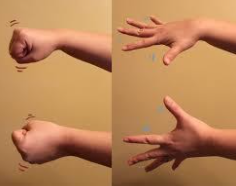Grounding
to keep you in the safety of the present- when the environment is safe, you CAN feel safe
Name 3–5 neutral things in the room that:
- You can see (e.g. by colour or shape);
- You can hear (e.g. the phone is ringing, a tram is passing by, the clock is ticking, someone is talking);
- Your body is sensing (e.g. a wooden armrest, the chair underneath you, your back against the chair, your toes in the shoe).
Safe space – RELAXING WITH THE HELP OF IMAGINATION
- Adjust your body into a comfortable position. Focus on your breathing for a moment, notice how you are breathing in and out. When you notice thoughts, look at them like clouds that are moving and that you are choosing to ignore, and focus on your breathing again. There is no need to strain.
- Observe as your muscles (the muscles in your neck, your shoulders, your abdominal and back muscles) relax and your body calms down. Continue breathing evenly.
- Now imagine yourself being in a place where you feel safe and calm. It can be a place from your current life or an earlier time, and it can also be an imaginary place. It is important that you associate this place with feeling safe and protected in your mind.
- Notice the colours and the sounds, the scents.
- Notice your emotions and experience being overcome with feelings of security and peace.
- When your body feels safe and calm, you can add to that good feeling by gently slapping your knees with each your hands in turn; for example, left-right, left-right, for 6 times in total. This helps to store the good feeling in your corporeal memory.
- Finally, say to yourself ‘When I open my eyes, I will feel secure and calm.
- Adjust your body into a comfortable position. Focus on your breathing for a moment, notice how you are breathing in and out. When you notice thoughts, look at them like clouds that are moving and that you are choosing to ignore, and focus on your breathing again. There is no need to strain.
- Observe as your muscles (the muscles in your neck, your shoulders, your abdominal and back muscles) relax and your body calms down. Continue breathing evenly.
- Now imagine yourself being in a place where you feel safe and calm. It can be a place from your current life or an earlier time, and it can also be an imaginary place. It is important that you associate this place with feeling safe and protected in your mind.
- Notice the colours and the sounds, the scents.
- Notice your emotions and experience being overcome with feelings of security and peace.
- When your body feels safe and calm, you can add to that good feeling by gently slapping your knees with each your hands in turn; for example, left-right, left-right, for 6 times in total. This helps to store the good feeling in your corporeal memory.
- Finally, say to yourself ‘When I open my eyes, I will feel secure and calm.’
CALMING BREATHING
- Breathe through your nose – taking long, slow, even, quiet breaths.
- Try to breathe with your diaphragm. The diaphragm lifts on inhalation and lowers on exhalation. Relax your chest. It does not lift or lower much. You may put one hand on your diaphragm and the other hand on your chest. That way, you can observe which area you are using to breathe. Count to four when breathing in and out.
- It is important for the exhalation to last for at least as long as the inhalation. If you are focusing in the exhalation, it is easy to make the inhalation longer.
- Practise for 5–10 minutes every day.
- Bonus exercise. Relaxing breathing: when you breathe in, say to yourself ‘calm’, and when you breathe out, say ‘relax’.

